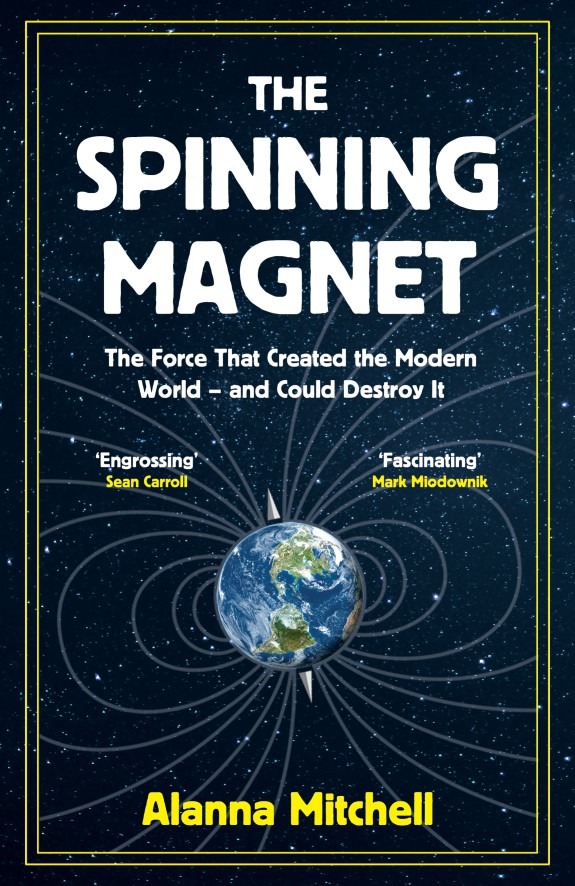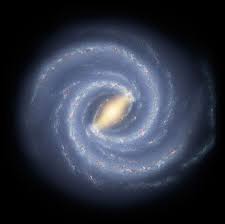
Beginning with the first investigations into electromagnetism, "The Spinning Magnet: The Force that Created the Modern World - and Could Destroy it" (Oneworld) charts a fascinating history of one of the most powerful forces in the universe. Award-winning science journalist Alanna Mitchell reveals how the Victorians made their pivotal discoveries, delves into unseen and unforeseen natural forces that threaten our planet, and warns of a possible future where solar radiation storms wipe out power grids and electronic communication across the globe. Here, she discusses some of the hidden stories and warnings in the book.
I became fascinated with the history of magnetism while I was in the Arctic doing research on the grisly tale of Sir John Franklin, the Victorian explorer who tried to complete the Northwest Passage. He and his 128 men and their two ships went missing in the 1840s. His ship HMS Erebus was finally found in 2014. So I was on King William Island in the Arctic with the Inuk historian, Louie Kamookak, learning about Franklin and tracking the sailors’ doomed trek to cannibalism and death. But the thing is that Franklin was not just trying to sail through the Northwest Passage. He was part of what was known as the “Magnetic Crusade,” the first international scientific collaboration. It was aimed at understanding the strange force within the Earth that pulled the compass. The quest enthralled me. And while I was there on King William Island, I was camping out on the land with my Inuit companions and one night, the skies lit up with spectacular green sheets of Northern Lights, or aurora borealis. Seeing the aurora is one of the few times we humans can see our planet’s magnetic field. I needed to understand how the field had come to be and why.
You write that "magnetism is one of the few essential powers of the universe". Could you expand?
Scientists are aware of only four physical forces of the universe. The one most of us know best is gravity; it holds us here on the Earth. Then there are two that govern what happens within atoms: the strong and the weak nuclear interactions. The fourth is electromagnetism, the force that holds matter together. Each of these forces is inescapable. Each is indispensable to the workings of the universe.
You explore the legacy of Bernard Brunhes, an often forgotten French physicist. Who was he, and what did he discover?
In 1905, Bernard Brunhes, a young physicist in Clermont-Ferrand in central France, packed his saddlebag with a compass and chisel, got on his horse and rode for hours to a new road-cut in the volcanic heart of France. He had been looking for a long time for a very special geological formation: a stretch of terracotta over which a volcano had once spewed hot lava. This new road cut exposed exactly that formation. It was special because terracotta contains unusual iron-based molecules that are capable of becoming fossil compasses, recording the coordinates of the magnetic field. But when terracotta heats up, say, by lava flowing overtop, it loses its magnetic coordinates until it cools down again, at which point it locks in the coordinates of the field at that moment. So that particular geological formation was interesting to someone like Brunhes, who was trying to figure out how magnetism works.
He took samples of the terracotta and when he examined them back at his lab, he discovered that when the terracotta had cooled down after the lava erupted five million years before, the North pole had been on the opposite side of the planet from where it was in 1905. In other words, the planet’s magnetic poles were capable of switching places and had done so at least once. He wrote a paper on this in 1906. It was the first paper to make the heretical suggestion that the poles could reverse places and it caused a scientific firestorm. Scientists had no way of understanding why a reversal was possible.
Why do you think his legacy has been overlooked?
Brunhes died of a stroke at 42, just four years after his controversial paper was published. He didn’t get the chance to write on the subject again or defend his finding. It fell to generations of other scientists to prove not only that he was correct, but that the Earth’s magnetic field has changed direction hundreds of times in the past. However, the current phase of the Earth’s magnetic history is named after Brunhes.
Can you spell out the exact implications of Brunhes' discovery of a pole switch, and what it means?
We know now that the Earth’s magnetic field is generated deep within our planet’s secret inner reaches – its hot, solid inner core and liquid metallic outer core. Essentially, heat, stored in the core from the planet’s birth, is trying to get out and it is doing that slowly through convection. This heat moves through the molten metallic outer core, creating electric currents, which in turn create a magnetic field. The core is so vast that the magnetic field is also vast, stretching out into space. Space is not benign or empty. It is a violent, quick-changing, ferocious place filled with dangerous solar and galactic radiation. Our Earth’s magnetic field protects us from that radiation.
We also know that our Earth’s magnetic field tends to be organized around two poles – the north and the south. That’s what our compasses respond to here on the surface. But inside the outer core, the planet’s magnetic field is far more complex. Other magnetic factions are fighting with the two-pole system. Sometimes, because this huge molten outer core is by nature turbulent, they get strong enough to topple it. When that happens they assert themselves and instead of having two poles, here on the surface, we would have four or six or eight. That’s when the normally dominant two-pole system is forced to switch directions, and so the two poles migrate. North moves to the South and South moves to the North. It takes thousands of years. And during that time, the field wanes to just a tenth of its usual strength, allowing more dangerous radiation to come closer to the surface. The last time the poles switched places was 780,000 years ago.
Right now, there is tremendous, unusual activity within the outer core and scientists are wondering whether the poles are preparing to switch places again.
In what ways has the concept of magnetism historically been so contentious? Why?
To understand magnetism is to understand how the universe and the Earth and its creatures came to be. Traditionally, religious tracts have taken the on the job of describing that, rather than scientific ones. In more recent times, the religious and scientific explanations have been at odds.
For example, the Christian Bible was the primary geological text in the West until, in some cases, the 19th century. Anyone who tried to describe observations about geology – and therefore the age or structure of the planet and solar system or its origin – was seen to be contradicting the Bible. The keepers of Christian doctrine went to great lengths to discourage that. The fact that Galileo read and approved of William Gilbert’s great work on magnetism, De Magnete, published in England in 1600, was one of the four proofs of guilt brought against Galileo by the Inquisition.
What would the consequences be if we saw another pole switch?
The main concerns are about the Earth’s electrical and communications infrastructure, its satellites, its power grid and air travel. They have been developed and built during a time when the Earth’s magnetic field is strong and pretty stable. But they are susceptible to pulses of electromagnetic and particle radiation from space. When the poles switch places, the Earth will not be as protected from that type of energy and that infrastructure will be at risk. And the actual pole reversal, and therefore the weakening of the field, will take thousands of years.
There is also concern among some physicists about whether some of that dangerous radiation will reach the Earth’s surface and affect life on the planet. The atmosphere is a buffer against some of that radiation. But, for example, scientists say that during a reversal the Earth’s ozone layer will be abraded, allowing far more ultraviolet B radiation to strike the surface, particularly wherever the (potentially numerous) poles are at that time.
Another unknown is precisely how creatures that use the magnetic field to navigate will handle a reversal, particularly those whose populations are already under threat of extinction from human activities. I think of sea turtles and whales and birds, among many others. Experiments are showing that these creatures can recalibrate their magnetic compasses swiftly, so that’s a comfort. And they also navigate by the sun and stars and landmarks, so they may have other mechanisms for getting to breeding spots and food sources. But we humans have had such a dire effect on so many species already, that I wonder how a reversal will add to their travails.
Are you optimistic?
Always! Scientists don’t know whether the poles are reversing right now. They can’t rule it out or confirm it. They know that the field is weakening and that the North magnetic pole is moving very fast – at 55 kilometres a year to the northwest. And they know that the field has switched direction at the outer edge of the outer core over about a fifth of the Earth’s surface in the southern hemisphere. That is causing a low field – like the bruise on an apple – over a swath of the Earth from one side of Africa to the other side of South America, called the South Atlantic Anomaly.
But even if the field is in the throes of a reversal, the field as a whole is still strong right now. And we have time to try to cope with the fallout.

